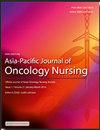Machine learning models to predict 6-month mortality risk in home-based hospice patients with advanced cancer
IF 2.4
3区 医学
Q1 NURSING
引用次数: 0
Abstract
Objective
This study aimed to construct predictive models using five different machine learning algorithms for predicting 6-month mortality risk among home-based hospice patients with advanced cancer.
Methods
This population-based retrospective prognostic study examined data from 7023 patients in a home-based hospice center. Various algorithms including logistic regression, random forest, XGBoost, support vector machine, and neural network were implemented in this study. The model performance and effectiveness were assessed using sensitivity, specificity, accuracy, the area under the curve (AUC), and F1 Score. Additionally, a nomogram was developed to calculate individualized risk probabilities, enhancing clinical utility.
Results
Among the five types of predictive models, the logistic regression model achieved an AUC of 0.754 (95% CI: 0.721–0.786) in the test dataset, outperforming other machine learning algorithms. The nomogram developed from the logistic regression model included 10 independent risk factors for 6-month mortality. The Hosmer–Lemeshow test showed no significant difference between the predicted and observed outcomes (training set: 12.646, P = 0.13; testing set: 3.807, P = 0.87). Clinical decision curve analysis indicated that the model provided substantial net benefits across a wide range of thresholds.
Conclusions
Our study demonstrated that routinely collected healthcare data on the first home visit have the potential to help screen high-risk patients, which may provide evidence for targeted hospice care.
机器学习模型预测晚期癌症家庭临终关怀患者6个月的死亡风险
目的利用五种不同的机器学习算法构建预测模型,预测晚期癌症居家安宁疗护患者6个月死亡风险。方法:这项以人群为基础的回顾性预后研究调查了7023名家庭安宁疗护中心患者的资料。本研究采用了逻辑回归、随机森林、XGBoost、支持向量机、神经网络等算法。采用敏感性、特异性、准确性、曲线下面积(AUC)和F1评分来评估模型的性能和有效性。此外,我们还开发了一个nomogram来计算个体化的风险概率,从而提高了临床的实用性。结果在五种预测模型中,逻辑回归模型在测试数据集中的AUC为0.754 (95% CI: 0.721-0.786),优于其他机器学习算法。由logistic回归模型得出的nomogram包括了6个月死亡率的10个独立危险因素。Hosmer-Lemeshow检验显示预测结果与观察结果无显著差异(训练集:12.646,P = 0.13;检验集:3.807,P = 0.87)。临床决策曲线分析表明,该模型在广泛的阈值范围内提供了实质性的净收益。结论首次家访时常规收集的医疗保健数据有可能有助于筛查高危患者,为有针对性的临终关怀提供依据。
本文章由计算机程序翻译,如有差异,请以英文原文为准。
求助全文
约1分钟内获得全文
求助全文
来源期刊

Asia-Pacific Journal of Oncology Nursing
Multiple-
CiteScore
2.80
自引率
11.10%
发文量
136
审稿时长
31 days
 求助内容:
求助内容: 应助结果提醒方式:
应助结果提醒方式:


